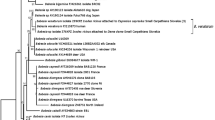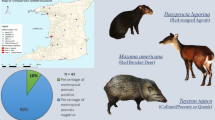Abstract
The aim of this work was to examine if the game species from the north-western Poland, roe deer (Capreolus capreolus), red deer (Cervus elaphus) and wild boar (Sus scrofa), may be reservoir hosts of bacteria from the genus Bartonella, and whether the sheep tick (Ixodes ricinus) is their vector. To this end, the prevalence of Bartonella DNA in the tissues of these game species was measured, just as in sheep ticks (I. ricinus) infesting them, and ticks collected from plants in the hunting area. The prevalence of Bartonella DNA was 39% (23/59) in roe deer and 35% (7/20) in red deer. No Bartonella DNA was detected in any of the 21 wild boars. The presence of Bartonella DNAwas detected in 1.9% of ticks infesting roe deer (2/103), while no pathogen DNA was found in the 20 ticks infesting the red deer and the 3 ticks infesting wild boars, or the 200 ticks collected from plants. Amplicons of two different lengths were obtained; 198 bp, characteristic for B. bovis, and 317 bp, characteristic for B. schoenbuchensis, which were confirmed later by sequencing. The examined ruminants are probably the reservoir hosts of B. schoenbuchensis and B. bovis in the biotope of the Puszcza Wkrzańska Forest, and wild boars do not participate in the Bartonella propagation in the environment. I. ricinus is unlikely to be the main vector of Bartonella species detected in the examined roe deer and red deer; probably other bloodsucking arthropods, parasitizing wild ruminants, play this role.
Similar content being viewed by others
References
Bermond D., Boulouis H.J., Heller R., Van Laere G., Monteil H., Chomel B.B., Sander A., Dehio C., Piemont Y. 2002. Bartonella bovis Bermond et al. sp. nov. and Bartonella capreoli sp. nov., isolated from European ruminants. International Journal of Systematic and Evolutionary Microbiology, 52, 383–390. DOI: 10.1099/ijs.0.01839-0.
Boulouis H.J., Chang C.C., Henn J.B., Kasten R.W., Chomel B.B. 2005. Factors associated with the rapid emergence of zoonotic Bartonella infections. Veterinary Research, 36, 383–410. DOI: 10.1051/vetres:2005009.
Bown K.J., Bennet M., Begon M. 2004. Flea-borne Bartonella grahamii and Bartonella taylorii in bank voles. Emerging Infectious Diseases, 10, 684–687.
Breitschwerdt E.B., Sontakke S., Cannedy A., Hancock S.I., Bradley J.M. 2001. Infection with Bartonella weissii and detection of Nanobacterium antigens in a North Carolina beef herd. Journal of Clinical Microbiology, 39, 879–882. DOI: 10.1128/JCM.39.3.879-882.2001.
Chang C.C., Chomel B.B., Kasten R.W., Heller R., Kocan K.M., Ueno H., Yamamoto K., Bleich V.C., Pierce B.M., Gonzales B.J., Swift P.K., Boyce W.M., Jang S.S., Boulouis H.J., Piemont Y. 2000. Bartonella spp. isolated from wild and domestic ruminants in North America. Emerging Infectious Diseases, 6, 306–311.
Chang C.C., Chomel B.B., Kasten R.W., Romano V., Tietze N. 2001. Molecular evidence of Bartonella spp. in questing adult Ixodes pacificus tick in California. Journal of Clinical Microbiology, 39, 1221–1226. DOI: 10.1128/JCM.39.4.1221-1226.2001.
Dehio C., Lanz C., Pohl R., Behrens P., Bermond D., Piemont Y., Sander A. 2001. Bartonella schoenbuchii sp. nov., isolated from the blood of deer. International Journal of Systematic and Evolutionary Microbiology, 51, 1557–1565.
Dehio C., Sauder U., Hiestand R. 2004. Isolation of Bartonella schoenbuchensis from Lipoptena cervi, a blood-sucking arthropod causing deer-ked dermatitis. Journal of Clinical. Microbiology, 42, 5320–5323. DOI: 10.1128/JCM.42.11.5320-5323.2004.
Domański C. (Ed.) 2000. Nieklasyczne metody statystyczne. Polskie Wydawnictwo Ekonomiczne, Warszawa.
Halos L., Jamal T., Maillard R., Girard B., Guillot J., Chomel B., Vayssier-Taussat M., Boulouis H.J. 2004. Role of Hippoboscidae flies as potential vectors of Bartonella spp. infecting wild and domestic ruminants. Applied and Environmental Microbiology, 70, 6302–6305. DOI: 10.1128/AEM.70.10.6302-6305.2004.
Kobus P., Pietrzykowski R., Zieliński W. (Eds.). 2001. Statystyka z pakietem STATISTICA. Fundacja Rozwój SGGW, Warszawa, 86–90.
Maillard R., Riegel P., Barrat F., Bouillin C., Thibault D., Gandoin C., Halos L., Demanche C., Alliot A., Guillot J., Piemont Y., Boulouis H.J., Vayssier-Taussat M. 2004a. Bartonella chomelii sp. nov., isolated from French domestic cattle (Bos taurus). International Journal of Systematic and Evolutionary Microbiology, 54, 215–220. DOI: 10.1099/ijs.0.02770-0.
Maillard R., Vayssier-Taussat M., Bouillin C., Gandoin C., Halos L., Chomel B., Piemont Y., Boulouis H.J. 2004b. Identification of Bartonella strains isolated from wild and domestic ruminants by a single-step PCR analysis of the 16S–23S intergenic spacer region. Veterinary Microbiology, 1, 63–69. DOI:10.1016/j.vetmic.2003.09.022.
Morozova O.V., Cabello F.C., Dobrotvorsky AK. 2004. Semi-nested PCR detection of Bartonella henselae in Ixodes persulcatus ticks from Western Siberia, Russia. Vector Borne Zoonotic. Diseases, 4, 306–309.
Sanogo Y.O., Zeaiter Z., Caruso G., Merola F., Shpynov S., Brouqui P., Raoult D. 2003. Bartonella henselae in Ixodes ricinus ticks (Acari: Ixodida) removed from humans, Belluno Province, Italy. Emerging Infectious Diseases, 9, 329–332.
Schouls L.M., Van De Pol I., Rijpkema S.G., Schot C.S. 1999. Detection and identification of Ehrlichia, Borrelia burgdorferi sensu lato, and Bartonella species in Dutch Ixodes ricinus ticks. Journal of Clinical Microbiology, 37, 2215–2222. DOI: 0095-1137/99/$04.0010.
Schulein R., Seubert A., Gille C., Lanz C., Hansmann Y., Piemont Y., Dehio C. 2001. Invasion and persistent intracellular colonization of erythrocytes: a unique parasitic strategy of the emerging pathogen Bartonella. Journal of Experimental Medicine, 193, 1077–1086. DOI: 10.1084/jem.193.9.1077.
Author information
Authors and Affiliations
Corresponding author
Rights and permissions
About this article
Cite this article
Adamska, M. Wild ruminants in the area of the North-Western Poland as potential reservoir hosts of Bartonella schoenbuchensis and B. bovis . Acta Parasit. 53, 407–410 (2008). https://doi.org/10.2478/s11686-008-0058-z
Accepted:
Published:
Issue Date:
DOI: https://doi.org/10.2478/s11686-008-0058-z




